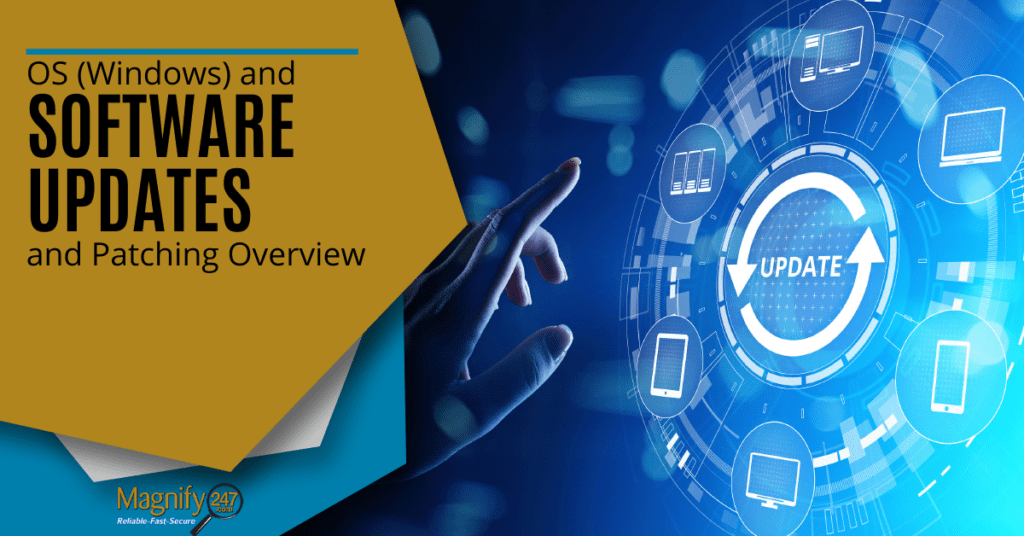
It seems every time you turn around, another system on your computer is asking for an update. Some of them just give you an annoying popup, while others may bring your system to a screeching halt while you’re waiting for something to update.
watch the video > https://youtu.be/Vcc7O5Ub4Tw
Many users turn off automatic updates for that reason. They don’t want to be interrupted with an update that they have to deal with unexpectedly. But what can happen is that unapplied updates and patches can get backed up and leave your system completely vulnerable to a data breach.
Not using patch management and leaving vulnerabilities exposed is the cause of a majority of data breaches and security incidents.
Some of the main reasons that companies put off those vital updates are:
- Unsure what apps and devices need updating across their organization (76%)
- Can’t take critical systems offline to apply patches (74%)
- It’s too hard to prioritize patch and update management (72%)
But not having a managed services plan or other systems for keeping all your devices properly updated can mean big problems.
What’s the Difference Between Update & Patch?
There are several different areas of a company’s IT infrastructure that need to be kept updated. The increasing number of different types of devices that are used in business has also contributed to the problem many companies have keeping up with those patches and updates. They just don’t have the time!
There are three main types of systems that are updated:
- Operating Systems: This would be updates for Windows or your mobile device (iOS or Android)
- Software/Applications: These are the applications you use that are updated regularly, like Microsoft Office or an app like Slack.
- Firmware: Firmware updates are updates to the systems that run hardware components. You’ll have firmware updates for your computer, router, and other IoT devices.
For each of these three areas, you’ll often hear the term “update” or “patch” and here is what each of those mean.
Update
A device update is simply any package of code that you install to update areas of your operating system or software. An “update” can also include a security “patch,” which is a fix specifically designed to correct a vulnerability.
An update for your OS, software, or firmware can include:
- New features
- Bug fixes
- Security patches
- Software or hardware compatibility enhancements
Patch
A patch, or security patch, is specifically designed to fix something in the code of an OS or software that could be exploited by a hacker to breach the device in some way. These are often created after a breach has happened that exposes the system vulnerability.
Sometimes patches will come as part of a larger feature update and sometimes they’re pushed out in small updates simply meant to seal a found vulnerability.
Why is Applying Updates Regularly Important?
If you leave vulnerabilities unpatched, your entire network can be susceptible to a breach.
“Vulnerabilities” are pieces of the code that can be exploited by a hacker to release malware, take over certain areas of an application or OS, or something similar.
Risks of not patching your computer include:
- Being infected with a virus or malware
- Having a hacker infiltrate your system
- Breach of confidential information
- Potential to infect other devices on a network
How Micro-Patching Can Solve the Updates Problem
Companies that fall behind on updates typically do it because they don’t have time and don’t want to take software or devices offline to go through an update.
One way that business disruption can be avoided is by using micro-patching. Because of the way that micro-patching applies miniature patches of code to devices, it’s able to patch system vulnerabilities just as soon as any type of patch is released but without the disruption of waiting on a larger update.
Some of the benefits of using micro-patching to handle software vulnerabilities are as follows.
No Reboots or Downtime
Having to reboot and wait an unspecified amount of time for an update to apply is typically a “no go” for people in the middle of a busy workday. Micro-patching can be done without the need to take your system down, which is a huge timesaver.
Automated Process
The micro-patching process is automated, so you don’t have to worry whether or not a device is missing a critical security update. It all happens behind the scenes without any interruption to the user.
Vital Patches are Applied Faster
You’re ahead of the game when it comes to using micro-patching because any security vulnerabilities are applied just as soon as there is a patch available. This ensures that you have the most solid security possible that can even protect you from zero-day threats.
Sign Up for Micro-Patching Today at Magnify247.com
Stop struggling with security patches and have them handled for you automatically without any downtime.






